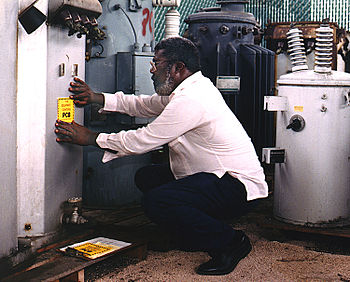355
| Labelling PCB-containing transformers. (Photo credit: Wikipedia) |
Polychlorinated biphenyl or PCBs are man-made compounds that were first made in 1881 and were extensively used as cooling agents in electrical equipment such as transformers and capacitors and also as additives in paints, pesticide extenders, flame retardants etc. Monsanto was a major producer of this chemical in the early phases.
Although PCBs had extensive applications. just like other man made plastics, they do not breakdown naturally. As early as 1922, preliminary studies revealed that exposure to PCBs was detrimental to human and animal health. While initial reports suggested that the dangers extended to skin conditions alone, further reports linked PCBs to liver damage and poisoning. In the year 1968, about 400000 birds died after the feed that was supplied to them had been contaminated with PCBs. Detailed studies later also linked the exposure of PCBs to cancer.
Multiple such incidents around the globe, finally led to banning of production of PCBs in the United States in the year 1979. Since PCBs do not disintegrate naturally, the risk of exposure to PCBs still continues. The physical method of destruction of PCBs is extremely expensive and while the chemical method is affordable, it requires temperatures in the range of 700-900 degrees Celsius. Apart from the cost and process consideration, the fact that PCBs containing instruments and devices have been dumped in various landfills and dump yards all around the world, makes it difficult to collect and dispose. Additionally, if the PCBs from these sources find their way into water bodies, entire city could be at risk of exposure.
Researchers at the National University of Singapore have now been successful in identifying three new bacteria that can potentially be used to clear up PCBs. Hailing from the genus Dehalococcoides,
these bacteria carry special enzymes in them that can break down PCBs by removing the chlorine groups from the compound, thus paving way to new methods of dealing with PCBs.





